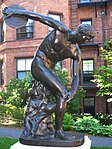Lincoln's Inn Society
Lincoln's Inn Society was the only social club based at Harvard Law School, in Cambridge, Massachusetts. Its name echoed Lincoln's Inn in London, which is one of the four Inns of Court where English barristers are based. Originally, Lincoln's Inn was known as Choate Inn of the International Legal Fraternity of Phi Delta Phi but became a private club when the Harvard Faculty voted to ban all fraternities in 1907. The Inn was a student-run refuge where students meet to relax after hard weeks of study. As a student-owned club, Lincoln's Inn is beyond university regulation. The Inn had a diverse and dynamic membership that was open to all members of the HLS community. Lincoln's Inn membership was once strictly male but it now admits women, and women have been President of the Society on numerous occasions. It has become especially popular with first-year students as a way to meet their classmates. Lincoln's Inn Society merged with HL Central in 2007, following declining membership and a lack of funds.
Excerpt from the Wikipedia article Lincoln's Inn Society (License: CC BY-SA 3.0, Authors).Lincoln's Inn Society
Follen Street, Cambridge
Geographical coordinates (GPS) Address Nearby Places Show on map
Geographical coordinates (GPS)
| Latitude | Longitude |
|---|---|
| N 42.378444444444 ° | E -71.121083333333 ° |
Address
Follen Street 44;46
02163 Cambridge
Massachusetts, United States
Open on Google Maps









